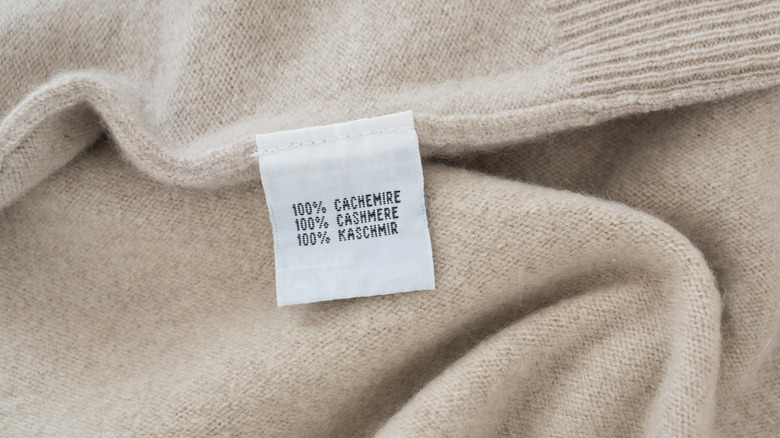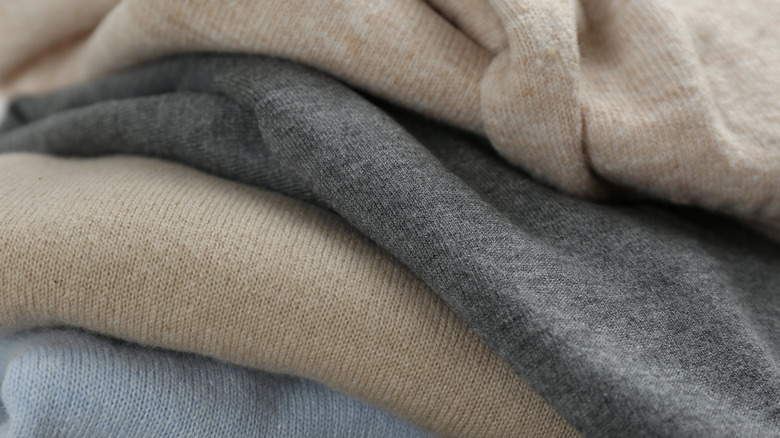Why Is Cashmere So Expensive?
Sweater season is here, but some materials will keep you warmer than others. While fabrics like cotton are good for warm weather, they won't do anything to insulate your body when the temperature drops. Enter the two most popular warm sweater materials: cashmere and wool. One of the real differences between cashmere and wool is the texture. Most ready-to-buy sweaters are a wool blend and can feel itchy if you have sensitive skin.
On the other hand, cashmere is known for its softness and is generally thought of as less itchy than wool, hence its popularity and luxury connotations. If you're looking for the best cashmere sweaters, some more affordable options have been introduced into the market over the past few years, including Uniqlo's offerings and Reformation's cute cropped cardigan sets, as reported by Harper's Bazaar.
However, these products are still out of the budget for many of us and are also often blended with other fibers such as cotton and polyester to bring costs down, making them less high-end overall. So, what is it about cashmere that makes it so luxurious, and more importantly, why is it so expensive?
The fabric is more difficult to obtain than it seems
According to Insider, one of the reasons cashmere is so expensive is due to the way it is obtained. Cashmere does not come from sheep, like wool, but instead from cashmere goats. These goats produce a very limited amount of cashmere in comparison to wool, and their cashmere layer is only harvested once a year. In addition to this, cashmere goats are only native to a handful of select countries. In fact, cashmere goats are only 0.05% of the world's goat population, per ThreadCurve.
The rarity of these goats, coupled with the short time period of being able to collect cashmere from them, creates a scarcity price rise. Moreover, cashmere needs to go through a specific process when dyed in order to retain its softness. This process is more time-consuming than the regular fabric dyeing process, which once again contributes to the price hike of cashmere products.
However, as Slate notes, "whiter cashmere fibers require less dye." This means that lighter sweaters get less damaged in the dyeing process, and it's also probably why neutral cashmere sweaters are more commonly seen on the market. Both of these factors further elevate cashmere into a luxury product with a high price tag.
Cashmere is often thought of as a luxury material
Interestingly, the sustainability and ethics rating website Good On You states that cashmere is biodegradable and a renewable resource. However, getting cashmere from cashmere goats is often a tough task. Cashmere goats can be treated roughly, with reports suggesting that some are in visible pain during the long and arduous shearing and combing process. Though cashmere is a more sustainable material and will keep you warm and snug during freezing temperatures, perhaps stick to vintage cashmere items if you don't want to support the cashmere industry — thrifted pieces will be less expensive, too.
Another major factor of expensive cashmere is the grade of it used for your sweater. A 100% Grade 1 cashmere sweater, for instance, can cost upwards of $500 (via Insider), whereas cashmere products like those sold by Uniqlo are thought to be more affordable due to the lower grade of cashmere used. But it's worth noting that the lower the grade of cashmere the less durable the product (via Inside Hook).
Overall, cashmere is expensive because of the rarity of cashmere goats, the extensive dyeing process, and the care that has to be taken to retain its natural softness. Keep all of this in mind before putting your hand in your wallet.


